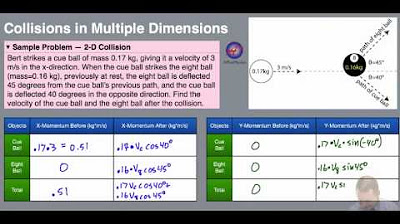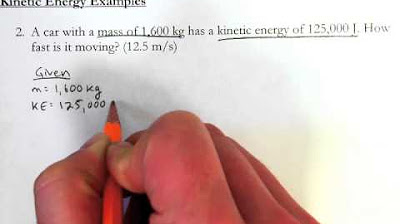Treating systems (the hard way) | Forces and Newton's laws of motion | Physics | Khan Academy
TLDRThe video script presents a classic physics problem involving two masses, 3 kg and 5 kg, connected by a rope that passes over a pulley. The challenge is to determine the acceleration of each mass. The narrator explains the function of a pulley, which is to transfer force from one direction to another without loss, assuming no resistance or mass. The problem-solving approach begins with Newton's second law, applying it to both masses in their respective directions. Initially, this leads to two equations with two unknowns (acceleration and tension). The crucial insight is that the magnitudes of the accelerations must be equal due to the system's constraints, allowing the creation of a single equation with one unknown. After solving for the acceleration of the 5 kg mass, the acceleration of the 3 kg mass is easily found by using their relationship. The video concludes with a solution: the 5 kg mass accelerates at 3.68 m/s² horizontally, while the 3 kg mass accelerates at -3.68 m/s² vertically, indicating a downward motion. The methodical approach and the final solution are engaging, demonstrating the application of physics principles to real-world problems.
Takeaways
- 📚 The problem presented involves two masses tied together by a rope passing over a pulley, and it's a classic physics problem found in textbooks.
- 🔍 A pulley is a rotating mechanism that can transfer force from one direction to another, turning vertical forces into horizontal forces or vice versa.
- 🎯 Newton's second law is used to find acceleration, which is the net force in a given direction divided by the mass.
- 🔄 The forces acting on the 5 kg mass are gravity, a normal force, and a tension force to the right, while the 3 kg mass experiences gravity and tension.
- 🧲 The tension in the rope is the same on both sides of the pulley if the pulley has negligible mass and no resistance.
- 📐 A force diagram is essential to visualize and calculate the forces acting on each mass.
- 🔁 The accelerations of the two masses are not independent; the 3 kg mass accelerates downward while the 5 kg mass accelerates horizontally, with equal magnitudes but opposite directions.
- ⚖️ The key to solving the problem is recognizing that the magnitude of accelerations must be the same for both masses to maintain the integrity of the rope without breaking or stretching.
- 🔢 The final step involves algebraic manipulation to solve for the acceleration of the 5 kg mass, which then allows for the calculation of the 3 kg mass's acceleration.
- 📉 The acceleration of the 3 kg mass is found to be negative, indicating downward acceleration, while the 5 kg mass has a positive acceleration, indicating horizontal movement to the right.
- 📈 The calculated acceleration for the 5 kg mass is approximately 3.68 meters per second squared, and for the 3 kg mass, it is -3.68 meters per second squared.
Q & A
What is the classic physics problem presented in the transcript?
-The classic physics problem involves finding the acceleration of two masses tied together by a rope that passes over a pulley.
What is a pulley and how does it function in this problem?
-A pulley is a small piece of plastic or metal that can rotate and has a groove for a string or rope to pass over. It allows the transfer of force from one direction to another, turning vertical forces into horizontal forces or vice versa.
Why is it assumed that the tension on both sides of the pulley is equal?
-The tension is assumed to be equal because if the pulley can spin freely without resistance and has negligible mass, there is no reason for the tension to differ on either side.
What is Newton's second law as applied to this problem?
-Newton's second law is used to find acceleration by stating that the acceleration in a given direction is equal to the net force in that direction divided by the mass.
How does the force diagram help in solving the problem?
-The force diagram helps to visualize and account for all the forces acting on the masses, including gravity, normal force, and tension, which are necessary to apply Newton's second law.
What is the key argument made to link the accelerations of the two masses?
-The key argument is that if the 3 kg mass moves down a certain amount, the 5 kg mass must move forward by the same amount to provide the necessary rope length. This implies that the magnitudes of their accelerations must be the same, with opposite signs due to the direction of movement.
Why is it necessary to consider both the vertical and horizontal directions when applying Newton's second law?
-Considering both directions is necessary because the problem involves forces and accelerations in both the vertical (for the 3 kg mass) and horizontal (for the 5 kg mass) directions. This helps to account for all forces acting on the system.
How is the acceleration of the 5 kg mass in the horizontal direction related to the acceleration of the 3 kg mass in the vertical direction?
-The acceleration of the 3 kg mass in the vertical direction is equal in magnitude but opposite in direction to the acceleration of the 5 kg mass in the horizontal direction. This is due to the system's constraint that the rope does not stretch or break.
What is the final calculated acceleration for the 5 kg mass in the horizontal direction?
-The final calculated acceleration for the 5 kg mass in the horizontal direction is 3.68 meters per second squared.
What is the acceleration of the 3 kg mass, and why is it negative?
-The acceleration of the 3 kg mass is -3.68 meters per second squared. It is negative because the mass is accelerating downward, and downward acceleration is considered negative in the given coordinate system.
What is the 'easy way' to solve such problems, which will be presented in the next video?
-The 'easy way' to solve these problems is not detailed in the transcript, but it is implied that there is a more straightforward or simplified method that will be explained in the subsequent video, which would likely make use of the system's symmetry and constraints.
Outlines
📚 Introduction to the Physics Problem
The first paragraph introduces a classic physics problem involving two masses connected by a rope over a pulley. The pulley is explained as a device that can rotate freely to transfer force from one direction to another. The challenge is to find the acceleration of a 3 kg mass and a 5 kg mass. The speaker warns that they will first demonstrate the more complex method to solve the problem, as understanding this will make the simpler method clearer and is often required by educators.
🔍 Applying Newton's Second Law to Find Acceleration
The second paragraph delves into applying Newton's second law to find the acceleration of the 5 kg mass in the horizontal direction. The forces acting on the 5 kg mass are identified: gravity, normal force, and tension. A force diagram is used to visualize these forces. The speaker acknowledges the difficulty in solving the problem due to the unknown acceleration and tension. The approach then shifts to considering the 3 kg mass and its forces in the vertical direction, noting that the tension in the rope is the same on both sides of the pulley, assuming no resistance or mass from the pulley.
🔗 Linking the Accelerations of the Two Masses
The third paragraph discusses the crucial step of linking the accelerations of the two masses. The argument is made that for the system to work without the rope breaking or stretching, the 3 kg mass moving down must result in the 5 kg mass moving forward by the same amount. This leads to the conclusion that the magnitudes of acceleration for both masses must be the same, with opposite directions due to their respective movement. This insight allows the problem to be solved by combining the equations for both masses and solving for a single variable.
🧮 Solving for the Accelerations
The final paragraph walks through the algebraic process of solving for the acceleration of the 5 kg mass in the horizontal direction (A5X), using the relationship established between the accelerations of the two masses. After finding A5X to be 3.68 meters per second squared, the acceleration of the 3 kg mass (A3Y) is determined by using the previously established relationship, resulting in an acceleration of -3.68 meters per second squared, indicating downward movement. The paragraph concludes by summarizing the process: applying Newton's second law to both masses, linking their accelerations due to the system's constraints, and solving the resulting equation to find the accelerations.
Mindmap
Keywords
💡Pulley
💡Acceleration
💡Newton's Second Law
💡Tension
💡Mass
💡Gravity
💡Force Diagram
💡Normal Force
💡Friction
💡Rope Stretch
💡Direction
Highlights
This is a classic physics problem involving two masses tied together by a rope passing over a pulley
The pulley is a rotating piece of plastic or metal that allows force to be transferred from one direction to another
If the pulley is massless and frictionless, the tension on both sides will be equal
Apply Newton's second law to find the acceleration of each mass by dividing the net force by the mass
Choose the horizontal direction for the 5 kg mass and the vertical direction for the 3 kg mass
Identify all the forces acting on each mass - gravity, normal force, and tension
Set up two equations for the net force on each mass, but you have two unknowns - acceleration and tension
Realize the accelerations of the two masses are not independent - they must have the same magnitude
The 3 kg mass has a downward acceleration while the 5 kg mass has an equal upward acceleration
Express the acceleration of the 3 kg mass in terms of the acceleration of the 5 kg mass
Substitute this relationship into one of the net force equations to eliminate the tension variable
Solve the resulting equation for the acceleration of the 5 kg mass in the horizontal direction
Find the acceleration to be 3.68 m/s^2 for the 5 kg mass and -3.68 m/s^2 for the 3 kg mass
The key insight is that the two masses must accelerate at the same rate to prevent the rope from breaking or stretching
This problem demonstrates the power of Newton's laws and the importance of free-body diagrams
The hard way of solving the problem involves setting up equations for both masses and linking their accelerations
In the next video, an easier method for solving this type of problem will be presented
Transcripts
Browse More Related Video

Finding the Tension and Acceleration for a Two Mass Pulley (with Friction)

Newton's Second Law Exam Question: Two-body systems Pulley practice

AP Physics - Collisions in Multiple Dimensions

Net Force Physics Problems With Frictional Force and Acceleration

Kinetic Energy - Introductory Example Problems

AP Physics Workbook 2.K Acceleration of Systems
5.0 / 5 (0 votes)
Thanks for rating: